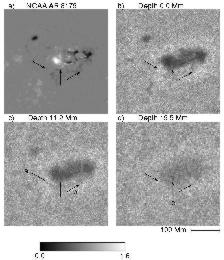
A cut-away of the interior of the Sun, showing the wave fronts of
acoustic radiation used to image active regions on the far surface.
Click on the picture for a high-resolution version, or click here
for a QuickTime animation.

Local Helioseismology, a term first appearing in print in
1993, is a relatively new field in solar physics which uses
ambient sound waves (called ``p modes'') propagating throughout the
interior of the Sun to probe local inhomogeneities in
the solar interior
or on its surface. This field complements the traditional approach
of what we may now term
``global'' helioseismology,
whose principal goal has been the measurement, identification, and
modeling of the resonant oscillation modes of the Sun (especially their
frequencies) to deduce the global properties of the solar interior.
Since the
discovery in 1987
that sunspots are strong absorbers of incident p modes,
Doug Braun
and his collaborators have been
designing and applying new tools in
local helioseismology to explore the acoustic properties of
solar magnetic regions and other small-scale perturbations.
Although sunspots and other magnetic regions are in many ways
the most obvious local structures on the Sun, there are other
types of perturbations which local helioseismology is ideally suited
to explore, such as the
solar meridional flow.
An ongoing collaboration between Braun and Charles
Lindsey has
lead to the successful development and application of
Helioseismic Holography, first discussed
over a decade ago. Helioseismic Holography is a general formalism for
producing diffraction-limited seismic images of the solar interior.
Diagnostics of acoustic power holography include the detection of
sources and sinks of acoustic waves on the Sun,
such as the absorption inside sunspots and the high-frequency
emission
Helioseismic holography has also been used to image active regions
on the far surface of the Sun (the side facing
away from the Earth). The figure appearing at the top of this page
shows acoustic wave fronts traveling between a point source on the
far (left) side and the near (right) side where they are observed.
These observed waves are propagated backwards in time (computationally) through
a model of the Sun
to reconstruct the wave amplitudes on the far-side, thereby constructing
an image of the acoustic perturbations (mainly surface magnetic fields)
at the far surface. With this procedure, we now have
the ability to predict the appearance of solar active regions up to
a week or more before they rotate around to the front side. This has
important implications for space weather forecasting. Large active
regions are often the sites of solar flares and coronal mass ejections
which can disrupt communications and electrical power transmission on
Earth, and endanger the health of astronauts working in space. Thus
an early-warning system to detect
the presence of these regions well in advance of their appearance
on the near side of the Sun has significant practical utility.
Far-side Imaging of the Sun
Holography of active region NOAA 9636:
A comparison of SOI-MDI and GONG+ observations.
 (acoustic glories)
surrounding complex active regions.
This figure shows
helioseismic images of the active region complex
NOAA 8179 obtained for the 24 hour period 1998 March 16.
The figure shown is reduced in resolution for bandwidth. Click
the image for a high-resolution version.
Frame a shows a concurrent SOHO SOI-MDI magnetogram.
Frames b, c, and d show 5 mHz helioseismic images of
the regions with depths at 0, 11.2 and 19.5 Mm below the solar
surface, respectively.
Sunspots and their immediate surrounding show up dark in
these seismic images, indicating that up to half of all
incident acoustic radiation is absorbed.
The acoustic glory is
quite conspicuous in frame b as a bright halo of excess 5 mHz emission
surrounding the entire active region complex.
(figure from
Braun and Lindsey 1999)
Phase-sensitive
procedures are also being applied to solar data extend the utility of
holography to probe the thermal, magnetic and Doppler properties of
active regions and their surroundings.
(acoustic glories)
surrounding complex active regions.
This figure shows
helioseismic images of the active region complex
NOAA 8179 obtained for the 24 hour period 1998 March 16.
The figure shown is reduced in resolution for bandwidth. Click
the image for a high-resolution version.
Frame a shows a concurrent SOHO SOI-MDI magnetogram.
Frames b, c, and d show 5 mHz helioseismic images of
the regions with depths at 0, 11.2 and 19.5 Mm below the solar
surface, respectively.
Sunspots and their immediate surrounding show up dark in
these seismic images, indicating that up to half of all
incident acoustic radiation is absorbed.
The acoustic glory is
quite conspicuous in frame b as a bright halo of excess 5 mHz emission
surrounding the entire active region complex.
(figure from
Braun and Lindsey 1999)
Phase-sensitive
procedures are also being applied to solar data extend the utility of
holography to probe the thermal, magnetic and Doppler properties of
active regions and their surroundings.
For a list of relevant publications see
Doug Braun's homepage
Also see the following pages for more information:
This research uses solar observations obtained primarily from the Solar Oscillations Investigations - Michelson Doppler Imager on SOHO and the Global Oscillations Network Group (GONG), and is funded by the National Science Foundation and the National Aeronautics and Space Administration.